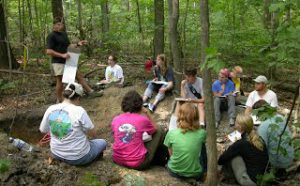Co-listed as NRE 430 – ENVIRON 430 – EEB 489 (Fall)
Soils are a central component of terrestrial ecosystems. Major emphasis for this course is placed on physical, chemical, and biological properties and their relationships to plant growth and ecosystem processes. Understanding of these soil components is developed using a combination of lectures, field and laboratory exercises and individual research. The function of soils in forested ecosystems is the primary focus; however, examples are drawn from a wide range of terrestrial ecosystems.
- How the interactions of landform, topography, climate, and biota over time lead to the patterns of soil development and the distribution of soil types that we observe within the landscape;
- How physical, chemical, and biological properties of forest soils affect water and nutrient availability to plants and, ultimately, ecosystem productivity; and
- How nutrients are cycled within forest ecosystems and how these processes are influenced by land management practices.
In the field portion of the course, we will sample and describe soils of four forest ecosystems and observe first-hand how differences in landform, topography, climate, and biota influence soil development. In the laboratory we will analyze our soil samples for a number of physical, chemical, and biological properties. Using these data in conjunction with field data, each student will select two of the four ecosystems for detailed comparison in a term paper. Although we will focus our attention on local forest ecosystems of Michigan, skills learned in this course may be broadly applied within a variety of terrestrial ecosystem types in other geographic regions.
Students are expected to have a background in chemistry and biology. In particular, a working knowledge of chemical equilibria, ionic solution chemistry, pH, and oxidation-reduction reactions is highly recommended. Students without such background should consult with the instructor before enrolling. Also useful (although not required) is familiarity with biochemistry, plant physiology, microbiology, geology, and local flora. You will find it very helpful if you have had, or are currently enrolled in, Woody Plants (ENVIRON 337). The lectures and laboratory exercises in Soil Properties and Processes have been designed to complement Forest Ecology (ENVIRON 435), and we highly recommend that you enroll in these courses concurrently.


